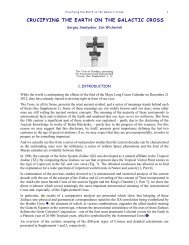Thusanang - Souls of Distortion
Thusanang - Souls of Distortion
Thusanang - Souls of Distortion
Create successful ePaper yourself
Turn your PDF publications into a flip-book with our unique Google optimized e-Paper software.
possible), and groupings <strong>of</strong> individual children and brothers and<br />
sisters who can provide each other with mutual support.<br />
The cost <strong>of</strong> this initial 2 year phase <strong>of</strong> the project is AUD520,000<br />
which will support 350 orphans and vulnerable children and enable<br />
the construction <strong>of</strong> a simple elegant operational Child Care Centre at<br />
Mount Moorosi (we have assumed support for half <strong>of</strong> the estimated<br />
700 orphans and vulnerable children at Mount Moorosi). This<br />
document is being distributed to obtain this funding to enable this<br />
project to continue.<br />
The Problem<br />
The vast beautiful isolation <strong>of</strong> the highlands<br />
which form a large part <strong>of</strong> Lesotho. Living<br />
in these harsh regions is very difficult.<br />
Lesotho is a land-locked mountain kingdom surrounded<br />
by South Africa. The economy is heavily dependent on<br />
agriculture and exporting water and labour to the South<br />
African mines. There has been a significant amount <strong>of</strong><br />
retrenchment <strong>of</strong> workers from the mines over the past five<br />
years, leaving many families with little or no income.<br />
Many <strong>of</strong> the miners also returned to Lesotho with HIV/AIDS and other<br />
chronic health problems. According to the HIV/AIDS surveillance<br />
data reported by the Ministry <strong>of</strong> Health and Social Welfare (2000), the<br />
HIV prevalence rate in the country is 30%. In a joint report issued by<br />
UNAIDS/UNICEF/UNAID, ‘Children on the Brink’ (2002), it was<br />
reported that by 2003 there would be an estimated 180,000 orphans<br />
in Lesotho, with 100,000 orphaned by AIDS and 49,000 <strong>of</strong> those<br />
children documented as double orphans (both parents deceased).<br />
On a recent fact-finding mission conducted by Lovelight <strong>of</strong> Byron Bay<br />
and the Justice and Peace Committee, our team visited three primary<br />
schools in the Qachas Nek and Quthing Districts and discovered that<br />
between one third and one half <strong>of</strong> the student body (135 students)<br />
were orphaned with approximately 100 single orphans and 25 to 35<br />
double orphans.<br />
The Need<br />
Orphans in Lesotho need alternatives to institutional care<br />
where extended families do not exist or cannot afford to<br />
care for them any longer. While the Lesotho village social<br />
structure provides extended family support for many <strong>of</strong><br />
the orphans, in many villages there remain dozens <strong>of</strong><br />
vulnerable children who are homeless, uncared for,<br />
sexually abused or at risk for other forms <strong>of</strong> exploitation,<br />
including prostitution.<br />
According to the United Nations Children’s Fund (Bjorn Ljungqvist,<br />
2003), ‘...throughout sub-Saharan Africa, there have been traditional<br />
systems in place to take care <strong>of</strong> children who lose their parents for<br />
various reasons. But the onslaught <strong>of</strong> HIV slowly but surely erodes<br />
this good traditional practice by simply overloading its caring capacity<br />
by the sheer number <strong>of</strong> orphaned children needing support and care.<br />
HIV also undermines the caring capacity <strong>of</strong> families and communities<br />
by deepening poverty due to loss <strong>of</strong> labour and the high cost <strong>of</strong><br />
medical treatment and funerals’<br />
Basotho village children<br />
Keeping orphans in school is crucial to their futures. While primary<br />
education is basically free in Lesotho through 7 th grade (as <strong>of</strong> 2005),<br />
many orphans are not in school due to extended family not being<br />
interested in educating them or able to afford other school fees.<br />
According to UNAID report ‘The Global HIV Epidemic, 2002’, 52% <strong>of</strong><br />
2















